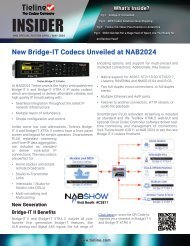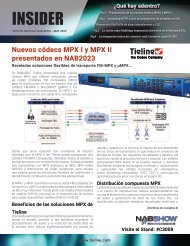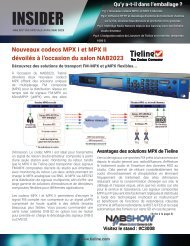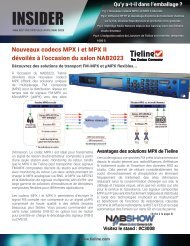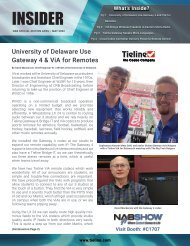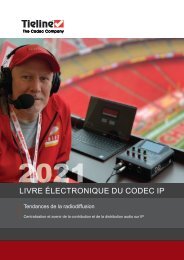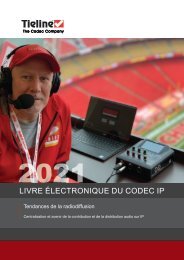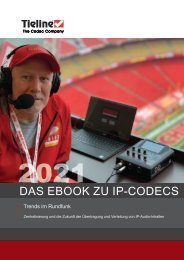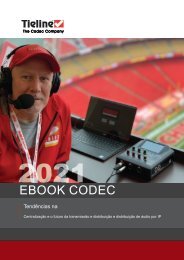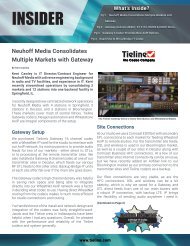Trends in IP Contribution & Distribution
Tieline’s new eBook explores the latest trends in IP Audio Contribution and Distribution. Understand the impacts of centralization on future hardware and software solutions in this FREE eBook
Tieline’s new eBook explores the latest trends in IP Audio Contribution and Distribution. Understand the impacts of centralization on future hardware and software solutions in this FREE eBook
You also want an ePaper? Increase the reach of your titles
YUMPU automatically turns print PDFs into web optimized ePapers that Google loves.
2021<br />
<strong>IP</strong> CODEC EBOOK<br />
Broadcast <strong>Trends</strong><br />
Centralization and the Future of <strong>IP</strong> Audio <strong>Contribution</strong> and <strong>Distribution</strong>
BROADCAST TRENDS<br />
Introduction<br />
2021<br />
There is no doubt that bus<strong>in</strong>ess, and the bus<strong>in</strong>ess of broadcast, is evolv<strong>in</strong>g fast. <strong>IP</strong>, AI and COVID-19<br />
have all accelerated technological change to the po<strong>in</strong>t that many broadcast networks are reth<strong>in</strong>k<strong>in</strong>g and<br />
re<strong>in</strong>vent<strong>in</strong>g their entire <strong>in</strong>frastructure design.<br />
For some, this may mean build<strong>in</strong>g fewer studios. For others, it may be <strong>in</strong>creas<strong>in</strong>g workplace flexibility to<br />
support work<strong>in</strong>g and broadcast<strong>in</strong>g remotely from home. What seems evident is that the studios we have<br />
been used to will shr<strong>in</strong>k or consolidate over time. Even before the pandemic, eng<strong>in</strong>eers were tell<strong>in</strong>g us<br />
they required boxes with greater channel density. Reasons for this varied: reduc<strong>in</strong>g studio rack space was<br />
common; expand<strong>in</strong>g capacity with<strong>in</strong> exist<strong>in</strong>g space was another.<br />
This eBook explores how <strong>IP</strong> Audio <strong>Contribution</strong> and <strong>Distribution</strong> <strong>in</strong>frastructure is adapt<strong>in</strong>g to the new<br />
landscape <strong>in</strong> radio broadcast<strong>in</strong>g. It details how the latest studio hardware and software solutions are<br />
be<strong>in</strong>g <strong>in</strong>tegrated <strong>in</strong>to exist<strong>in</strong>g and future studio designs. It will also explore the importance of remote<br />
control functionality to support REMI (Remote Integration) workflows.<br />
Tiel<strong>in</strong>e is a manufacturer, however we also play a role as a thought-leader <strong>in</strong> the world of broadcast. We<br />
will cont<strong>in</strong>ue to work with our customers and partners as we strive to cont<strong>in</strong>ually <strong>in</strong>novate and build the<br />
future of radio broadcast<strong>in</strong>g together. We have consulted widely <strong>in</strong> putt<strong>in</strong>g this eBook together and hope<br />
you f<strong>in</strong>d <strong>in</strong>formation with<strong>in</strong> it useful.<br />
William McLean<br />
Chief Executive Officer<br />
Tiel<strong>in</strong>e Group of Companies
BROADCAST TRENDS EBOOK<br />
CONTENTS<br />
THE BROADCAST PLANT IN 2021 AND BEYOND<br />
4<br />
AO<strong>IP</strong> COMPLIANCE DELIVERS FLEXIBLE CODEC<br />
STREAMING<br />
8<br />
MANAGING MULT<strong>IP</strong>LE REMOTES WITH GATEWAY<br />
13<br />
PATTISON MEDIA INSTALLS GATEWAY<br />
17<br />
THE NEW NORMAL FOR RADIO IN THE USA<br />
20<br />
THE LATEST ON RADIO IN EUROPE AND BEYOND<br />
22<br />
TIELINE SUPPORTS YOUR RADIO STREAMING NEEDS<br />
24<br />
REMOTE CONTROL OF BROADCAST DEVICES<br />
26<br />
BOOK A ZOOM DEMO<br />
27<br />
ENJOY OUR EBOOKS?<br />
29<br />
Tiel<strong>in</strong>e: The Codec Company<br />
3
The<br />
BROADCAST PLANT<br />
<strong>in</strong> 2021 and beyond...<br />
Even before the pandemic, centralization and consolidation had become a common<br />
theme <strong>in</strong> global radio. Some of the reasons for this <strong>in</strong>cluded:<br />
1. Cost reduction.<br />
2. Greater control, flexibility, and enhanced network security.<br />
3. Radio eng<strong>in</strong>eer<strong>in</strong>g skills shortages.<br />
Then the pandemic came along and supercharged this process. So what does the future<br />
hold from here?<br />
Scalability and More Remotes<br />
There is no doubt a large section of the radio community will cont<strong>in</strong>ue to broadcast<br />
remotely from home <strong>in</strong> the long term.<br />
Dur<strong>in</strong>g the pandemic this was forced<br />
upon us from a safety perspective,<br />
however, it is unlikely we will ever return<br />
back to the old ‘normal.’ Station owners<br />
quickly discovered remote broadcast<strong>in</strong>g<br />
on a wide scale is not only possible,<br />
<strong>in</strong> many situations it’s preferable<br />
as it creates efficiencies – such as<br />
remov<strong>in</strong>g long commutes to the station.<br />
Plus, many announcers and staff<br />
have embraced the flexibility remote<br />
broadcast<strong>in</strong>g delivers and will cont<strong>in</strong>ue<br />
to broadcast from home or ‘wherever<br />
the show may take them.’<br />
John Rogger us<strong>in</strong>g Report-IT to broadcast from<br />
home dur<strong>in</strong>g the pandemic.<br />
As a result, the flexibility of add<strong>in</strong>g new<br />
air talent from anywhere us<strong>in</strong>g scalable, high capacity Ao<strong>IP</strong> solutions will cont<strong>in</strong>ue to be<br />
imperative. Radio broadcasters will also want to <strong>in</strong>stall higher quality remote setups to<br />
replace temporary setups located at homes dur<strong>in</strong>g the pandemic.<br />
4 www.tiel<strong>in</strong>e.com
The Broadcast Plant<br />
<strong>in</strong> 2021 and beyond...<br />
Centralization Delivers More Control and Enhanced Security<br />
The move toward centralized broadcast facilities and content delivery requires audio<br />
codecs to do more, or as they say <strong>in</strong> the Ao<strong>IP</strong> world, have higher density. As radio station<br />
operations cont<strong>in</strong>ue to consolidate, content will be delivered from fewer locations, so<br />
codecs generally require more channels.<br />
Centraliz<strong>in</strong>g radio network resources delivers more control of network <strong>in</strong>frastructure.<br />
It is much simpler to ma<strong>in</strong>ta<strong>in</strong> equipment that is collocated, rather than travel<strong>in</strong>g vast<br />
distances to update, upgrade, and ma<strong>in</strong>ta<strong>in</strong> gear <strong>in</strong> different locations. Accelerated<br />
development of cloud-based <strong>in</strong>frastructure and remote software solutions have provided<br />
the <strong>in</strong>terfaces that allow eng<strong>in</strong>eers to configure and control equipment remotely.<br />
Centralization creates other efficiencies as collocated resources can be shared between<br />
stations more easily. For example, stations can allocate a sub-group of channels on a 16<br />
channel Gateway codec to one station and another sub-group of channels to another.<br />
Even though the stations are run <strong>in</strong>dependently, critical broadcast <strong>in</strong>frastructure can be<br />
shared to reduce costs.<br />
From a network security perspective, it is much easier to secure centralized equipment<br />
than it is to secure many dispersed sites. Logistically it takes more effort to secure<br />
distributed sites around the country and there are more potential po<strong>in</strong>ts of entry for<br />
hackers to exploit.<br />
Will Studios Downsize or Disappear?<br />
The trend towards more consolidation of media assets will have a profound effect on<br />
the size and buildout of the ma<strong>in</strong> studio. It’s <strong>in</strong>creas<strong>in</strong>gly evident that ma<strong>in</strong> studios will<br />
be significantly smaller and have a mix of higher capacity hardware and cloud-based<br />
solutions to reduce rack space requirements and provide more support for remote<br />
contribution. Smaller studio footpr<strong>in</strong>ts will free up resources for more remote equipment,<br />
but the elim<strong>in</strong>ation of studios completely is likely still some way off. Hav<strong>in</strong>g a physical<br />
station presence <strong>in</strong> key markets is still important for most major radio networks.<br />
Is Software the Future for Broadcast Eng<strong>in</strong>eer<strong>in</strong>g?<br />
There’s also been a lot of talk about whether station hardware will be completely<br />
replaced by software solutions. On the studio side, more software is be<strong>in</strong>g <strong>in</strong>tegrated to<br />
replace hardware. However, it’s likely that a mix of hardware and software solutions will<br />
Tiel<strong>in</strong>e: The Codec Company<br />
5
The Broadcast Plant<br />
<strong>in</strong> 2021 and beyond...<br />
cont<strong>in</strong>ue <strong>in</strong>to the foreseeable future, with software<br />
already dom<strong>in</strong>at<strong>in</strong>g the command and control sphere<br />
of device management.<br />
At the remote end, quick remotes and newsbased<br />
contributions are enhanced by apps and<br />
software applications that improve quality when<br />
compared to the regular phone calls. However, when<br />
broadcast<strong>in</strong>g network programs for extended periods<br />
away from the studio, a robust codec solution is<br />
preferable. Preferred solutions are capable of<br />
connect<strong>in</strong>g multiple cellular or wired <strong>in</strong>terfaces and<br />
deliver multiple redundant <strong>IP</strong> streams to prevent<br />
packet loss.<br />
Tiel<strong>in</strong>e ViA remote codec be<strong>in</strong>g used by<br />
Dan Israel at the Chiefs Radio Network<br />
To summarize, future studio designs will <strong>in</strong>corporate a mix of hardware and software<br />
Integrated solutions employ<strong>in</strong>g both hardware and software <strong>in</strong> radio broadcast<strong>in</strong>g.<br />
6 www.tiel<strong>in</strong>e.com
The Broadcast Plant<br />
<strong>in</strong> 2021 and beyond...<br />
solutions that provide:<br />
• Integrated options.<br />
• Full remote control.<br />
• Flexibility and scalability.<br />
Cost Reductions Will Cont<strong>in</strong>ue<br />
The relentless search for cost reductions<br />
will no doubt cont<strong>in</strong>ue. Centralized facilities<br />
create efficiencies through shar<strong>in</strong>g of<br />
resources and many major radio networks<br />
have also downsized their workforce <strong>in</strong><br />
recent times. This has affected a range<br />
Live and local broadcast<strong>in</strong>g is still<br />
important<br />
of jobs, <strong>in</strong>clud<strong>in</strong>g announcers. AI is be<strong>in</strong>g employed <strong>in</strong> a wide array of areas <strong>in</strong>clud<strong>in</strong>g<br />
programm<strong>in</strong>g, media monitor<strong>in</strong>g, ad verification, and transcription. This would appear to<br />
be the th<strong>in</strong> edge of the wedge and more AI services will emerge over time.<br />
However, there is also a significant benefit <strong>in</strong> ma<strong>in</strong>ta<strong>in</strong><strong>in</strong>g a local market presence and<br />
this will cont<strong>in</strong>ue to be an essential part of radio programm<strong>in</strong>g. Companies that do this<br />
best will reap the benefits of listenership and ad revenue.<br />
MCR: The Heart of Any Radio and TV Network<br />
Today’s studios at first glance are not too dissimilar to those of yesteryear. It all looks<br />
familiar; you’ll see a microphone, mix<strong>in</strong>g desk, a wall clock. It’s not until you dig deeper<br />
beh<strong>in</strong>d the console or Master Control (MCR) desk and racks that you f<strong>in</strong>d evidence of<br />
transformational change. Namely, all audio sources are carried over a s<strong>in</strong>gle ethernet<br />
cable <strong>in</strong> place of a spaghetti mix of copper cables.<br />
From the world of analog and TDM (Digital) studio networks with hundreds of cables<br />
term<strong>in</strong>at<strong>in</strong>g <strong>in</strong> MCR on Krone blocks, to one which is a centralized Audio over <strong>IP</strong><br />
Network leverag<strong>in</strong>g the latest IT <strong>in</strong>frastructure.<br />
There is still a large number of studios yet to make the transition to fully Ao<strong>IP</strong> based<br />
operations and a wide array of different proprietary and open standard technologies<br />
exist. The follow<strong>in</strong>g section will describe Tiel<strong>in</strong>e’s latest codecs, which deliver<br />
<strong>in</strong>teroperability with a range of Ao<strong>IP</strong> protocols, as well traditional analog and AES3 I/Os.<br />
Tiel<strong>in</strong>e: The Codec Company<br />
7
Ao<strong>IP</strong><br />
COMPLIANCE DELIVERS<br />
Flexible Codec Stream<strong>in</strong>g...<br />
Gateway Multichannel <strong>IP</strong> Codec<br />
Why is this important? To expand options and simplify workflows when <strong>in</strong>tegrat<strong>in</strong>g<br />
software and hardware from vendors support<strong>in</strong>g different <strong>IP</strong> protocols.<br />
After ref<strong>in</strong><strong>in</strong>g and perfect<strong>in</strong>g <strong>IP</strong> stream<strong>in</strong>g strategies <strong>in</strong> challeng<strong>in</strong>g remote broadcast<br />
environments over many years, Tiel<strong>in</strong>e is lead<strong>in</strong>g from the front to <strong>in</strong>tegrate<br />
uncompressed studio Ao<strong>IP</strong> streams with <strong>in</strong>bound compressed and uncompressed<br />
remote <strong>IP</strong> streams with<strong>in</strong> today’s broadcast plant.<br />
Gateway Delivers Flexible Ao<strong>IP</strong> Options<br />
The Gateway and Gateway 4 are Tiel<strong>in</strong>e’s latest codecs. They are often ‘edge’ devices<br />
<strong>in</strong> <strong>IP</strong> networks bridg<strong>in</strong>g between wide area network (WAN) nodes that may <strong>in</strong>clude the<br />
broadcast plant, other studios (<strong>in</strong>ter-studio l<strong>in</strong>ks), production facilities and live events.<br />
Broadcast eng<strong>in</strong>eers seek Ao<strong>IP</strong> devices that can transcend multiple technological<br />
standards and traverse across LANs, WANs and the public <strong>in</strong>ternet, a gateway of sorts<br />
with simple monitor<strong>in</strong>g and control. Why is this so important? Interoperability delivers<br />
greater flexibility when <strong>in</strong>tegrat<strong>in</strong>g <strong>IP</strong> audio streams <strong>in</strong>to the broadcast plant from a<br />
range of sources.<br />
8 www.tiel<strong>in</strong>e.com
Ao<strong>IP</strong> Compliance Delivers<br />
Flexible Codec Stream<strong>in</strong>g...<br />
Interoperability Improves Ao<strong>IP</strong> Workflows<br />
Gateway and Gateway 4 codecs are compliant with AES67 and SMPTE ST 2110-30 for audio<br />
transport. These standards provide the framework for transport<strong>in</strong>g uncompressed PCM audio<br />
around the broadcast plant. The AES67 and ST 2110-30 standards support Session Description<br />
Protocol (SDP) for configur<strong>in</strong>g the number of audio channels per stream, encod<strong>in</strong>g format, bits per<br />
sample, sampl<strong>in</strong>g frequency and number of samples <strong>in</strong> a packet.<br />
Watch as Charlie Gawley expla<strong>in</strong>s Ao<strong>IP</strong> protocol options <strong>in</strong> more detail<br />
Tiel<strong>in</strong>e codecs stream AES67 and ST 2110-30 compliant digital audio between<br />
equipment from manufacturers support<strong>in</strong>g these standards. They also support<br />
<strong>in</strong>stallation of an optional WheatNet-<strong>IP</strong> card. This provides a flexible platform for rout<strong>in</strong>g<br />
audio between a range of equipment us<strong>in</strong>g proprietary Ao<strong>IP</strong> protocols like WheatNet-<strong>IP</strong>,<br />
as well as devices support<strong>in</strong>g RAVENNA, AES67 and ST 2110-30.<br />
Even if studios <strong>in</strong>stall equipment us<strong>in</strong>g Ao<strong>IP</strong> protocols such as WheatNet-<strong>IP</strong>, Livewire+<br />
or Dante, <strong>in</strong> the real-world broadcast eng<strong>in</strong>eers often need the ability to connect and<br />
stream between equipment from different vendors. This is where AES67, RAVENNA,<br />
and ST 2110-30 for those <strong>in</strong> the TV world, provide a high degree of <strong>in</strong>teroperability with<br />
proprietary protocols such as Dante and Livewire+ (<strong>in</strong> AES67 compatibility mode).<br />
Tiel<strong>in</strong>e: The Codec Company<br />
9
Ao<strong>IP</strong> Compliance Delivers<br />
Flexible Codec Stream<strong>in</strong>g...<br />
The Gateway Ao<strong>IP</strong> codec supports connect<strong>in</strong>g with a variety of Ao<strong>IP</strong> protocols<br />
Simplify<strong>in</strong>g <strong>IP</strong> Stream Discovery<br />
and Advertisement<br />
AES67 and ST 2110-30 only address<br />
stream transport, packet setup and<br />
synchronization (tim<strong>in</strong>g). Noth<strong>in</strong>g is<br />
mandated regard<strong>in</strong>g discovery.<br />
Tiel<strong>in</strong>e offers optional WheatNet-<br />
<strong>IP</strong> cards at purchase to <strong>in</strong>terface<br />
directly with a WheatNet-<strong>IP</strong> network.<br />
Codecs then appear as Blades and<br />
seamlessly support stream discovery,<br />
advertisement and control us<strong>in</strong>g<br />
Wheatstone’s Navigator software.<br />
There are also other options for stream<br />
discovery and advertisement.<br />
Gateway codec added <strong>in</strong> Navigator<br />
10 www.tiel<strong>in</strong>e.com
Ao<strong>IP</strong> Compliance Delivers<br />
Flexible Codec Stream<strong>in</strong>g...<br />
Interoperability with NMOS, RAVENNA and Ember+<br />
Gateway and Gateway 4 codecs are compliant with AMWA NMOS standards IS-04<br />
and IS-05 which delivers discovery, registration, and ultimately control for ST 2110<br />
Ao<strong>IP</strong> stream<strong>in</strong>g. NMOS data models and open standard APIs deliver a new level of<br />
<strong>in</strong>teroperability and control with networked equipment throughout the stations and<br />
networks.<br />
NMOS will deliver more functions<br />
and greater <strong>in</strong>teroperability<br />
between <strong>IP</strong> devices from<br />
different vendors over time. More<br />
straightforward <strong>in</strong>teroperability<br />
between products is important as<br />
it allows end users and service<br />
providers to build better systems<br />
with streaml<strong>in</strong>ed management and<br />
control options.<br />
Available RAVENNA devices displayed <strong>in</strong> a<br />
Tiel<strong>in</strong>e codec<br />
Many broadcast networks around the world use RAVENNA for stream discovery and<br />
advertisement. The recent <strong>in</strong>tegration of RAVENNA allows Tiel<strong>in</strong>e codecs to perform<br />
these tasks over RAVENNA Ao<strong>IP</strong> networks.<br />
Align<strong>in</strong>g with Eng<strong>in</strong>eer<strong>in</strong>g Objectives<br />
“Ever s<strong>in</strong>ce the days of POTS and ISDN, Tiel<strong>in</strong>e has always advocated for<br />
<strong>in</strong>teroperability of equipment from different manufacturers,” said Charlie Gawley,<br />
Tiel<strong>in</strong>e’s VP Sales APAC/EMEA. “<strong>IP</strong> stream<strong>in</strong>g is no different and is why the Gateway is<br />
AES67, ST 2110-30, NMOS and RAVENNA compliant, to simplify workflows by allow<strong>in</strong>g<br />
devices from different vendors to connect seamlessly.”<br />
The Gateway and Gateway 4 also support Ember+, which is an openly available control<br />
protocol designed to <strong>in</strong>tegrate devices from different vendors <strong>in</strong>to a s<strong>in</strong>gle software<br />
<strong>in</strong>terface. Tiel<strong>in</strong>e’s NMOS and Ember+ capabilities will develop further and <strong>in</strong>tegrate<br />
over time via firmware updates.<br />
S<strong>IP</strong> and Phase-Aligned Stream<strong>in</strong>g<br />
All Tiel<strong>in</strong>e codecs support EBU3326 (Audio <strong>Contribution</strong> over <strong>IP</strong>) and EBU3347<br />
(Intercom over <strong>IP</strong>) S<strong>IP</strong> <strong>in</strong>teroperability standards. These important protocols allow<br />
Tiel<strong>in</strong>e: The Codec Company<br />
11
Ao<strong>IP</strong> Compliance Delivers<br />
Flexible Codec Stream<strong>in</strong>g...<br />
Tiel<strong>in</strong>e codecs to connect with non-Tiel<strong>in</strong>e devices. Plus, a Gateway codec can act as<br />
a S<strong>IP</strong> trunk-based gateway for public <strong>in</strong>ternet communication circuits between multiple<br />
venues at large sport<strong>in</strong>g events, or between locations over WANs.<br />
Demand for multichannel and surround sound stream<strong>in</strong>g options is also <strong>in</strong>creas<strong>in</strong>g and<br />
up to 8 channels of digital phase-aligned multichannel audio are supported <strong>in</strong> Gateway<br />
to provide a range of flexible alternatives. Selectable options <strong>in</strong>clude 6 channel (5.1 or<br />
6.0), 8 channel (7.1 or 8.0), and 4 channel phase-aligned streams.<br />
“With the multitude of use cases, <strong>IP</strong> protocols, and vendors supply<strong>in</strong>g equipment<br />
throughout the broadcast cha<strong>in</strong>, our customers are tell<strong>in</strong>g us they want to do more with<br />
less,” said Gawley. “In other words, fewer boxes, us<strong>in</strong>g less space, with lower power<br />
consumption and more functionality. Flexibility and <strong>in</strong>teroperability will be paramount<br />
go<strong>in</strong>g forward.”<br />
Neuhoff Media Consolidates Multiple Markets with Gateway<br />
Kerri Cawley is an IT Director/<br />
Contract Eng<strong>in</strong>eer for Neuhoff<br />
Media. “I recently designed new<br />
centralized network operations for<br />
Neuhoff Media with 4 stations <strong>in</strong><br />
Spr<strong>in</strong>gfield, 5 stations <strong>in</strong> Decatur,<br />
and 3 stations <strong>in</strong> Bloom<strong>in</strong>gton,”<br />
said Kerri. “These markets cover<br />
most of central Ill<strong>in</strong>ois.”<br />
“We purchased Tiel<strong>in</strong>e’s Gateway<br />
The Gateway 16 codec <strong>in</strong> action<br />
16 channel codec with a<br />
WheatNet-<strong>IP</strong> card for the studio to <strong>in</strong>terface with our Ao<strong>IP</strong> network. Its ma<strong>in</strong> purpose is<br />
to provide audio feeds for two of our markets – either direct to STLs, or to process<strong>in</strong>g at<br />
the remote transmitter sites,” said Kerri. “We also <strong>in</strong>stalled a Gateway 8 channel codec<br />
at one of our transmitter sites <strong>in</strong> Decatur, which feeds our various RF STL feeds to the<br />
other sites.”<br />
Full story at https://tiel<strong>in</strong>e.com/testimonials/neuhoff-consolidates-with-gateway/<br />
12 www.tiel<strong>in</strong>e.com
MULT<strong>IP</strong>LE REMOTES<br />
Manag<strong>in</strong>g<br />
with Gateway<br />
Tiel<strong>in</strong>e has specialized <strong>in</strong> stream<strong>in</strong>g low latency, high quality audio over wired and<br />
wireless <strong>IP</strong> networks for two decades. Envision<strong>in</strong>g future opportunities provided by <strong>IP</strong><br />
stream<strong>in</strong>g, Tiel<strong>in</strong>e embraced the development of cellular GSM, 3G, 4G, and now 5G <strong>IP</strong><br />
codec technologies, primarily to:<br />
• Broadcast from regions without POTS or ISDN l<strong>in</strong>es, and<br />
• Support broadcast<strong>in</strong>g <strong>in</strong> challeng<strong>in</strong>g<br />
remote broadcast environments.<br />
In the early days cellular bandwidth was<br />
very m<strong>in</strong>imal at best and required low<br />
bandwidth encod<strong>in</strong>g options with robust,<br />
adaptable jitter buffer strategies to avoid<br />
dropouts and network congestion. These<br />
strategies have been improved upon <strong>in</strong><br />
recent years with redundant stream<strong>in</strong>g<br />
and data aggregation (bond<strong>in</strong>g) improv<strong>in</strong>g<br />
bandwidth capability and <strong>IP</strong> packet stream<br />
reliability.<br />
Sean Fahey (left), Senior Broadcast<br />
Eng<strong>in</strong>eer at BYU Broadcast<strong>in</strong>g, oversees a<br />
live remote us<strong>in</strong>g the Tiel<strong>in</strong>e ViA codec<br />
Tiel<strong>in</strong>e: The Codec Company<br />
13
Manag<strong>in</strong>g Multiple Remotes<br />
With Gateway<br />
Remotes <strong>in</strong> 2022 and Beyond<br />
The pandemic forced many of us to work and broadcast remotely more often, <strong>in</strong> some<br />
cases permanently. So what does this mean for the future of remote broadcast<strong>in</strong>g?<br />
Primarily, there will cont<strong>in</strong>ue to be more remote broadcasts than ever before. The<br />
pandemic has demanded the availability of more remote solutions to ensure staff can<br />
work from home as required. Although not without its challenges, for most stations this<br />
has not necessarily been a bad th<strong>in</strong>g. It has created more live and local radio content,<br />
which <strong>in</strong> many ways delivered a more <strong>in</strong>timate auditory experience to listeners.<br />
It has also created opportunities to explore new ways of work<strong>in</strong>g. Announcers and<br />
eng<strong>in</strong>eers who previously had to travel long distances, or had time-consum<strong>in</strong>g<br />
commutes to the station, discovered they could broadcast successfully from home quite<br />
easily with the right equipment. Many stations have embraced new workflows and now<br />
see it as an opportunity to improve their employees’ quality of life.<br />
How Will Remote Technologies Evolve?<br />
It wasn’t that long ago that a studio requir<strong>in</strong>g two or three remote l<strong>in</strong>ks would need two<br />
or three rack mount codecs to receive <strong>in</strong>com<strong>in</strong>g audio, often tak<strong>in</strong>g up 2RU of rackspace<br />
each! How th<strong>in</strong>gs have changed. Consolidation of studio <strong>in</strong>frastructure <strong>in</strong>to more<br />
compact, higher density hardware and software has significantly reduced the footpr<strong>in</strong>t of<br />
equipment to <strong>in</strong>crease flexibility, save rack space and reduce energy costs.<br />
Redundancy Delivers Rock Solid Remotes<br />
It is likely that a mix of hardware and software<br />
solutions will be used for the foreseeable<br />
future. Software stream<strong>in</strong>g products are f<strong>in</strong>e<br />
for some applications, however hardware<br />
such as Tiel<strong>in</strong>e’s ViA codec delivers the<br />
level of robustness, reliability, and flexibility<br />
demanded by eng<strong>in</strong>eers for mission critical<br />
remote broadcasts. Remote codecs deliver<strong>in</strong>g<br />
network programm<strong>in</strong>g to large audiences<br />
require:<br />
• Network redundancy: redundant<br />
stream<strong>in</strong>g or data aggregation us<strong>in</strong>g<br />
multiple wired and wireless <strong>IP</strong> options.<br />
Sport reporter Paddy Sweeney us<strong>in</strong>g the Tiel<strong>in</strong>e<br />
ViA codec to <strong>in</strong>terview Melbourne’s premiership<br />
w<strong>in</strong>n<strong>in</strong>g capta<strong>in</strong> Max Gawn after the Australian<br />
Football League Grand F<strong>in</strong>al.<br />
14 www.tiel<strong>in</strong>e.com
Manag<strong>in</strong>g Multiple Remotes<br />
With Gateway<br />
• Power redundancy: the ability to run equipment on both ma<strong>in</strong>s and battery power.<br />
• Connection redundancy: multiple simultaneous connections deliver<strong>in</strong>g primary and<br />
redundant connections.<br />
ViA - More Than Just an <strong>IP</strong> Codec…<br />
Tiel<strong>in</strong>e’s flagship ViA remote codec offers mono, stereo, stereo plus mono, dual mono,<br />
and triple mono connection options, with network, power, and connection redundancy<br />
options. Connections are full-duplex and the ViA supports record, playback, and FTP<br />
use cases as well.<br />
View and manage record<strong>in</strong>gs, create playlists of local and imported files, then control<br />
playback rout<strong>in</strong>g to encoders and analog and digital outputs. It’s also simple to produce<br />
& record your own broadcast quality audio files to removable media, or simply upload<br />
files directly from the unit via FTP.<br />
Browser-based stream<strong>in</strong>g applications provide some affordable alternatives that<br />
are ideally suited to cut-<strong>in</strong>s or brief live crosses. However, they generally lack the<br />
redundancy features that deliver reliable remote broadcast<strong>in</strong>g <strong>in</strong> the most demand<strong>in</strong>g<br />
environments.<br />
Manag<strong>in</strong>g Multiple Simultaneous Remotes is Easy<br />
The ongo<strong>in</strong>g demand for more<br />
remotes requires higher density<br />
codecs like the Tiel<strong>in</strong>e Gateway,<br />
which can support up to 8<br />
stereo or 16 mono full-duplex<br />
connections <strong>in</strong> 1 rack unit of<br />
space.<br />
Us<strong>in</strong>g the built-<strong>in</strong> matrix editor<br />
you can set up a conference<br />
bridge with several <strong>in</strong>com<strong>in</strong>g<br />
remote contributions from<br />
multiple locations <strong>in</strong> addition<br />
to your <strong>in</strong>-studio hosts. The<br />
Gateway’s simple mix-m<strong>in</strong>us<br />
edit<strong>in</strong>g capability takes care<br />
Gateway supports 16 full-duplex stereo connections<br />
simultaneously<br />
Tiel<strong>in</strong>e: The Codec Company<br />
15
Manag<strong>in</strong>g Multiple Remotes<br />
With Gateway<br />
of unwanted audio sources, and it is all done at low latency. You would th<strong>in</strong>k your<br />
announcers and their guests were all sitt<strong>in</strong>g around a table <strong>in</strong> the same room!<br />
The Gateway also <strong>in</strong>cludes comprehensive <strong>in</strong>put process<strong>in</strong>g capabilities with EQ,<br />
a compressor/expander, and noise gat<strong>in</strong>g on each <strong>in</strong>put. Gateway also <strong>in</strong>cludes<br />
comprehensive remote-control capabilities through the HTML5 Toolbox web-GUI and<br />
can be fully configured and remotely controlled with the Cloud Codec Controller. This<br />
ensures control of all your remote connections is at your f<strong>in</strong>gertips anywhere, anytime.<br />
It’s simple to set up a mix-m<strong>in</strong>us for multiple remote feeds with Gateway us<strong>in</strong>g the built-<strong>in</strong> Matrix Editor<br />
16 www.tiel<strong>in</strong>e.com
Pattison Media<br />
INSTALLS GATEWAY<br />
By Barry Mandziak, Technical Supervisor for Pattison Media North Vancouver Island Operations.<br />
Pattison Media is Canada’s largest western based broadcast company.<br />
Bill Dean, morn<strong>in</strong>g show host on The Lounge 99.9FM<br />
Barry Mandziak,<br />
Technical Supervisor<br />
for Pattison Media<br />
North Vancouver Island,<br />
discusses how the<br />
Gateway consolidated<br />
network remotes dur<strong>in</strong>g<br />
the pandemic.<br />
Pattison Media is a grow<strong>in</strong>g media company. I am responsible for ma<strong>in</strong>ta<strong>in</strong><strong>in</strong>g<br />
operations for 6 Pattison Media stations on Vancouver Island. When the pandemic<br />
hit us early <strong>in</strong> 2020, our offices build<strong>in</strong>gs and studios <strong>in</strong> Nanaimo, Courtenay, and Port<br />
Alberni emptied out as folks were very concerned about the pandemic and decided to<br />
work from home.<br />
It was a busy time and lots of remote broadcast curve balls were suddenly thrown <strong>in</strong> my<br />
direction. This meant we had to ramp up our remote broadcast capabilities immediately<br />
to support announcers and producers work<strong>in</strong>g from home <strong>in</strong> remote studios. Our<br />
Nanaimo facilities are usually very busy with about 25—30 staff runn<strong>in</strong>g around mak<strong>in</strong>g<br />
radio go. Hav<strong>in</strong>g folks work<strong>in</strong>g from home was go<strong>in</strong>g to be a challenge. That is a lot of<br />
remote studios…. Be<strong>in</strong>g able to put a remote studio to air with little or no notice was<br />
now a reality.<br />
I made my way down to our equipment racks and thought this is not go<strong>in</strong>g to work.<br />
We had only 4 Tiel<strong>in</strong>e Bridge-IT units <strong>in</strong> place and we are runn<strong>in</strong>g six shows. I quickly<br />
realized we would need to scale up our codec capabilities. Added to this the need to<br />
receive two new audio feeds for two simultaneous morn<strong>in</strong>g shows. Then there is the<br />
possibility of remote broadcast cut <strong>in</strong>s… I knew that I would need more gear to make<br />
Tiel<strong>in</strong>e: The Codec Company<br />
17
Pattison Media<br />
Installs Gateway<br />
this work. That said, I have been us<strong>in</strong>g Tiel<strong>in</strong>e solutions for many years and found them<br />
very reliable. I knew exactly where I needed to go to get the bits and pieces that I would<br />
need to make this a go.<br />
F<strong>in</strong>d<strong>in</strong>g the Ideal Solution<br />
At first, I was look<strong>in</strong>g at<br />
purchas<strong>in</strong>g four more Bridget-<br />
IT codecs and add<strong>in</strong>g a lot<br />
more wire to our mix, however<br />
I did not have to go down this<br />
road at all. The folks at Tiel<strong>in</strong>e<br />
had a new product… the<br />
Gateway 8, and it appeared<br />
to be everyth<strong>in</strong>g I needed<br />
<strong>in</strong> one box. We purchased<br />
a s<strong>in</strong>gle Gateway 8, an<br />
4 Stereo Streams Configured on the Gateway 8<br />
8-channel <strong>IP</strong> codec that would be wired <strong>in</strong>to our Nanaimo studio location. The Gateway<br />
8 would service all four of our morn<strong>in</strong>g shows and all the remote cut <strong>in</strong>s mak<strong>in</strong>g our<br />
shows complete. We would repurpose our Bridge-IT units to be add-ons for our remote<br />
broadcast kits. Morn<strong>in</strong>g shows from anywhere was the hope.<br />
More Challenges<br />
Sett<strong>in</strong>g up remote studios and deal<strong>in</strong>g with the restrictions placed on us by COVID, we<br />
really needed an <strong>IP</strong> audio solution that delivered more advanced rout<strong>in</strong>g capabilities.<br />
The Gateway 8 would also give us the option to phase out our copper ISDN l<strong>in</strong>es<br />
completely and now rely on the Gateway 8 connected over fiber to Bridge-IT codecs.<br />
We also use the Report-IT Enterprise app extensively over cellular connections for both<br />
shows and remote cut <strong>in</strong>s.<br />
Work<strong>in</strong>g the Codec 24/7<br />
The Gateway 8 services two Parksville stations, CHPQ-FM and CIBH-FM as well as<br />
CHWF-FM and CKWV-FN both out of Nanaimo. The Gateway 8 codec really does<br />
have it all and it fits <strong>in</strong> one RU of rack space. The Gateway is connected pretty much<br />
24/7 on two stations and we’ve never had any dropouts or audio issues. With this new<br />
configuration we now do morn<strong>in</strong>g shows remotely from announcers’ homes and other<br />
locations that often change daily. We elected to use stereo connections and use Music<br />
PLUS encod<strong>in</strong>g at 256kbps and it sounds great. Announcers also have backhaul audio<br />
18 www.tiel<strong>in</strong>e.com
Pattison Media<br />
Installs Gateway<br />
that is studio quality. We also connect to the Gateway for remotes and for voice track<strong>in</strong>g.<br />
If anyone gets sick and needs to work from home, they can easily do their show from<br />
home us<strong>in</strong>g the Report-IT app as a codec and transport.<br />
The Gateway has a Toolbox HTML5 web-GUI software <strong>in</strong>terface that lets you monitor<br />
and configure any sett<strong>in</strong>gs remotely. This is great, but the truth is, s<strong>in</strong>ce I <strong>in</strong>stalled the<br />
Gateway 8 it hasn’t needed any reconfigurations. After <strong>in</strong>itial setup it’s all set and forget<br />
and just works. I do use the GUI sometimes to disconnect end users if someone forgets<br />
to hang up a codec. We also use Broadcast Tools switchers to feed the codec which<br />
also can be remotely controlled.<br />
We now have several additional channels of <strong>IP</strong> audio com<strong>in</strong>g <strong>in</strong>to our studios and we<br />
can route this audio pretty much anywhere. This upgrade has allowed us to get rid of<br />
all our copper ISDN l<strong>in</strong>ks and <strong>in</strong>creased flexibility. The sav<strong>in</strong>gs dropp<strong>in</strong>g all the copper<br />
ISDN and broadcast loops was appreciable. We can route return audio from almost<br />
anywhere us<strong>in</strong>g the built-<strong>in</strong> Matrix Editor and if you need contact closures you’ve got<br />
them too. The codec is also AES67/ST 2110-30 compliant, which will be useful as we<br />
digitize our studios more over time.<br />
I would like to take a moment to thank Jacob Daniluck and the folks at Tiel<strong>in</strong>e for<br />
build<strong>in</strong>g such a wonderful product. It’s been rock solid and there is so much flexibility. I<br />
couldn’t make radio work without the Tiel<strong>in</strong>e Gateway and I honestly cannot even th<strong>in</strong>k<br />
of a s<strong>in</strong>gle feature I would add to this unit. The Gateway 8 has it all… thank you Tiel<strong>in</strong>e.<br />
Watch the Video<br />
Watch the video to learn more about the Gateway Multichannel <strong>IP</strong> codec<br />
Tiel<strong>in</strong>e: The Codec Company<br />
19
The New Normal for<br />
RADIO IN THE USA<br />
By Doug Ferber, VP Sales Americas<br />
As we have been say<strong>in</strong>g <strong>in</strong> the multitude<br />
of Zoom presentations that we have been<br />
do<strong>in</strong>g over the past 18 months, remote<br />
broadcast<strong>in</strong>g is here to stay. It makes<br />
too much sense fiscally for management<br />
to completely go back to the old way of<br />
do<strong>in</strong>g th<strong>in</strong>gs. The big guys of network<br />
radio are f<strong>in</strong>ally tuned <strong>in</strong> to the technical<br />
aspects of the <strong>in</strong>dustry to f<strong>in</strong>d ways to<br />
save on expenses. Smaller ma<strong>in</strong> studio<br />
footpr<strong>in</strong>ts, elim<strong>in</strong>ation of many peripheral<br />
or small regional broadcast<strong>in</strong>g locations,<br />
and less equipment <strong>in</strong> the rack that can<br />
accomplish more. A big lunchroom and<br />
jock lounge may be go<strong>in</strong>g the way of the<br />
d<strong>in</strong>osaur.<br />
Doug Ferber with the Tiel<strong>in</strong>e ViA remote codec<br />
The audio quality from home studios can be excellent with the right gear and reasonable<br />
acoustics. As eng<strong>in</strong>eers know, if you want it to sound like the jocks are <strong>in</strong> the studio,<br />
you don’t use cheap solutions. I personally recommend resist<strong>in</strong>g the temptation to use<br />
PC based software… go with rock solid hardware for more dependable, long-last<strong>in</strong>g,<br />
high-quality set-ups.<br />
ViA is the Ultimate Remote Option<br />
The ViA is the top remote broadcast<strong>in</strong>g solution there is… period. It’s best <strong>in</strong> its class<br />
by a mile. It’s the “Ferrari” of remote codecs because of its elegant design and tough<br />
construction, abundant features and functionality. Everyth<strong>in</strong>g is built-<strong>in</strong>… I call it a<br />
“studio <strong>in</strong> a box”. In fact, <strong>in</strong> a p<strong>in</strong>ch you could use it to run one of your stations if your<br />
console melted down! We have many ViA owners that have retired (or used as boat<br />
anchors, paper weights, and door stops) competitors’ function<strong>in</strong>g remote codecs <strong>in</strong><br />
favor of the ViA. The phrase “you’ve tried the rest, now try the best” could not be more<br />
20 www.tiel<strong>in</strong>e.com
The New Normal<br />
For Radio <strong>in</strong> the USA<br />
appropriate than when referr<strong>in</strong>g to the ViA. As a standalone or as a complement to the<br />
ViA, our Report-IT app smartphone codec is also a very popular solution for remote<br />
broadcast<strong>in</strong>g. Another high quality, low latency solution from Tiel<strong>in</strong>e, that also <strong>in</strong>cludes<br />
features like redundant stream<strong>in</strong>g.<br />
With centralization be<strong>in</strong>g the new mantra, scalability is important. Hav<strong>in</strong>g the ability to<br />
scale up exist<strong>in</strong>g audio delivery equipment will be more favorable <strong>in</strong> the future than<br />
add<strong>in</strong>g more units to rack rooms featur<strong>in</strong>g less rack space. Tiel<strong>in</strong>e’s Gateway platform<br />
lets you purchase an 8-channel codec and upgrade it later to support up to 16 channels<br />
as required. Eng<strong>in</strong>eers have been gravitat<strong>in</strong>g to these codecs <strong>in</strong> <strong>in</strong>creas<strong>in</strong>g numbers as<br />
a result.<br />
Dur<strong>in</strong>g the early phase of the pandemic we observed that budget was often an<br />
issue. There was a lot of “wait and see” out there relat<strong>in</strong>g to <strong>in</strong>frastructure updates<br />
and equipment acquisitions. However, <strong>in</strong> recent months there has been an uptick <strong>in</strong><br />
purchases as networks who held off have decided it’s time to upgrade.<br />
Luckily for Tiel<strong>in</strong>e, several of our products can be used as high-quality home studio<br />
solutions, so we’ve been able to “defy gravity” better than many. In general, with ad<br />
spend return<strong>in</strong>g, the <strong>in</strong>dustry has been <strong>in</strong>creas<strong>in</strong>gly more buoyant throughout 2021,<br />
however challenges rema<strong>in</strong> as the <strong>in</strong>dustry fully adjusts to a new normal and new<br />
listen<strong>in</strong>g habits. As stream<strong>in</strong>g grows <strong>in</strong> com<strong>in</strong>g years, products like our Gateway will<br />
cont<strong>in</strong>ue to evolve with new features like HTTP stream<strong>in</strong>g and other Ao<strong>IP</strong> technologies<br />
<strong>in</strong>clud<strong>in</strong>g AES67, ST 2110-30, NMOS, RAVENNA, WheatNet-<strong>IP</strong> and more.<br />
Everyone is look<strong>in</strong>g forward to the day that the sun sh<strong>in</strong>es on the radio <strong>in</strong>dustry aga<strong>in</strong>.<br />
Hopefully that is soon and the result<strong>in</strong>g high tide will raise all ships.<br />
Tiel<strong>in</strong>e: The Codec Company<br />
21
The Latest on Radio<br />
IN EUROPE & BEYOND<br />
By Charlie Gawley, VP Sales APAC/EMEA<br />
Earlier <strong>in</strong> this publication we mentioned the adoption of<br />
proprietary and open standards for Audio over <strong>IP</strong> and<br />
I would like to expand on this topic a little more. The<br />
benefit of proprietary standards is that they conta<strong>in</strong> the<br />
secret sauce to provide unparalleled performance and<br />
reliability and are always cutt<strong>in</strong>g edge. Whereas open<br />
standards, if adopted as per the standard, provide a<br />
high degree of <strong>in</strong>teroperability.<br />
We at Tiel<strong>in</strong>e have always believed <strong>in</strong> provid<strong>in</strong>g<br />
Charlie Gawley, Tiel<strong>in</strong>e VP Sales<br />
APAC/EMEA<br />
broadcasters with the ability to <strong>in</strong>tegrate equipment as seamlessly as possible <strong>in</strong>to their<br />
broadcast plant. That is why we adopt the approach of embrac<strong>in</strong>g both proprietary and<br />
open standards-based architecture <strong>in</strong> our products. Back <strong>in</strong> 2006, Tiel<strong>in</strong>e was one of<br />
the early implementors of the EBU N/AC<strong>IP</strong> 3326 standard for <strong>in</strong>teroperability of codecs<br />
over <strong>IP</strong> us<strong>in</strong>g S<strong>IP</strong>.<br />
In terms of <strong>in</strong>dustry body driven open standards, you have the Audio Eng<strong>in</strong>eer<strong>in</strong>g<br />
Society’s (AES) AES67 that is regarded as predom<strong>in</strong>ately for radio. The Society of<br />
Motion Picture and Television Eng<strong>in</strong>eers (SMPTE) ST-2110-30 standard is for TV, and<br />
we also have the RAVENNA open standard by ALC Networks. The key to support<strong>in</strong>g<br />
open standards is ensur<strong>in</strong>g your <strong>in</strong>vestment <strong>in</strong> equipment is compliant with the standard,<br />
rather than partially compatible. As a customer, the consequence of purchas<strong>in</strong>g<br />
hardware or software with partial implementation of standards, could mean you have<br />
<strong>in</strong>vested <strong>in</strong> equipment that does not work as expected.<br />
The product brief may state “AES67 Compliant,” however, you f<strong>in</strong>d you can’t send or<br />
receive 6 mono channels <strong>in</strong> a s<strong>in</strong>gle AES67 stream from another device, even though<br />
the standard states 1-8 channels. Or it may state that they support AES67 and as a<br />
customer you f<strong>in</strong>d that their Ao<strong>IP</strong> PC driver does not support AES67, this then has<br />
ramifications with your Automation setup <strong>in</strong>terfac<strong>in</strong>g with other equipment.<br />
22 www.tiel<strong>in</strong>e.com
The Latest on Radio<br />
In Europe and Beyond<br />
It is for this very reason the Audio Eng<strong>in</strong>eer<strong>in</strong>g Society <strong>in</strong> 2018 issued a revision of<br />
the AES67 standard to <strong>in</strong>clude Protocol Implementation Conformance Statement,<br />
AES67-2018 PICS. This enables <strong>in</strong>tegrators and eng<strong>in</strong>eers to evaluate exactly which<br />
capabilities and options of the protocol have been implemented. For the implementation<br />
of NMOS, ST-2110, ST-2059, ST-2110-30 and ST-2022-7, the Jo<strong>in</strong>t Taskforce on<br />
Network Media (JT-NM) has published test<strong>in</strong>g tools for compliance.<br />
As they say, the devil is <strong>in</strong> the detail, and a little time <strong>in</strong>vested <strong>in</strong> research upfront can<br />
save you time and money <strong>in</strong> the long term. Information on the JT-NM test<strong>in</strong>g program<br />
and test plan downloads are available at https://www.jt-nm.org/ and the AES standards<br />
are available at https://www.aes.org/standards/.<br />
The Transformation of Transmission and <strong>Distribution</strong> of Audio<br />
The traditional medium for radio transmission over the airwaves, be it AM, FM, DAB+,<br />
DRM or HD Radio, is rapidly transition<strong>in</strong>g to radio be<strong>in</strong>g wherever you are – whether<br />
that’s at your desk, on the tra<strong>in</strong>, or out exercis<strong>in</strong>g. Stream<strong>in</strong>g audio over <strong>IP</strong> to Content<br />
Delivery Networks facilitates feed<strong>in</strong>g multiple onl<strong>in</strong>e devices such as your cell phone,<br />
PC or connected devices such as Alexa, Apple and Google smart speakers. To follow<br />
we will explore this <strong>in</strong> more detail.<br />
Tiel<strong>in</strong>e: The Codec Company<br />
23
Tiel<strong>in</strong>e Supports Your<br />
RADIO STREAMING<br />
Needs<br />
How will the role of stream<strong>in</strong>g change for radio <strong>in</strong> the next five years? It is generally<br />
agreed that stream<strong>in</strong>g will be ever more important as more people consume more audio<br />
onl<strong>in</strong>e. Younger generations <strong>in</strong> particular gravitate to onl<strong>in</strong>e stream<strong>in</strong>g platforms, but<br />
<strong>in</strong>creas<strong>in</strong>gly, so are older listeners via smart speakers, apps, and other platforms.<br />
How Can My Codec Support My Stream<strong>in</strong>g Requirements?<br />
Tiel<strong>in</strong>e specializes <strong>in</strong> distribut<strong>in</strong>g high-quality broadcast audio between remote locations,<br />
studios, and affiliates with best-<strong>in</strong>-class Ao<strong>IP</strong> audio codecs. A software update to Tiel<strong>in</strong>e<br />
Gateway, Gateway 4 and ViA codecs now also delivers support for HTTP stream<strong>in</strong>g to<br />
Icecast and SHOUTcast servers.<br />
Gateway codec acts as HTTP stream<strong>in</strong>g server to HTTP clients<br />
Along with a range of other <strong>IP</strong> <strong>in</strong>novations, this delivers greater stream<strong>in</strong>g flexibility to<br />
broadcasters employ<strong>in</strong>g a range of stream<strong>in</strong>g applications across diverse radio network<br />
<strong>in</strong>frastructure. Your codec can now:<br />
1. Receive live remote broadcast streams and distribute <strong>IP</strong> audio to transmitter sites,<br />
remote studios, and affiliates over the <strong>in</strong>ternet.<br />
24 www.tiel<strong>in</strong>e.com
Tiel<strong>in</strong>e Supports Your<br />
Radio Stream<strong>in</strong>g Needs<br />
2. Integrate Ao<strong>IP</strong> audio around the broadcast plant us<strong>in</strong>g AES67, ST 2110-30,<br />
RAVENNA, NMOS, and Ember+.<br />
3. Deliver an Icecast or SHOUTcast HTTP stream to an onl<strong>in</strong>e audience.<br />
4. Facilitate Icecast client stream<strong>in</strong>g support as one of several failover options when<br />
distribut<strong>in</strong>g broadcast audio signals.<br />
This means Tiel<strong>in</strong>e codecs now support be<strong>in</strong>g an <strong>in</strong>tegral part of network radio<br />
strategies that encompasses stream<strong>in</strong>g high quality, low latency audio for traditional<br />
radio remote contribution and distribution use cases, as well as HTTP stream<strong>in</strong>g<br />
applications.<br />
Stream<strong>in</strong>g: Increas<strong>in</strong>gly An Important Broadcast Component<br />
If you believe that you have to be where listeners are migrat<strong>in</strong>g to, then stream<strong>in</strong>g<br />
needs to be a bigger part of a radio company’s strategy. Recent data for the US<br />
measur<strong>in</strong>g stream<strong>in</strong>g <strong>in</strong>dicates<br />
rapid growth for adults 25-54. As a<br />
result, advertisers more widely are<br />
acknowledg<strong>in</strong>g the need to <strong>in</strong>clude<br />
stream<strong>in</strong>g <strong>in</strong> their advertis<strong>in</strong>g mix.<br />
Tiel<strong>in</strong>e’s Doug Ferber is VP Sales<br />
for the Americas and has seen a<br />
lot of change <strong>in</strong> the radio <strong>in</strong>dustry<br />
over several decades. “There<br />
are still radio operators out there<br />
that don’t believe stream<strong>in</strong>g is a<br />
critical distribution channel for their<br />
content,” said Doug. “Remember<br />
cable TV <strong>in</strong> the seventies? How<br />
Codecs that support HTTP stream<strong>in</strong>g deliver<br />
more flexible connection options to radio<br />
eng<strong>in</strong>eers<br />
many people do you know today that watch television exclusively us<strong>in</strong>g an over-the-air<br />
signal?”<br />
“Tiel<strong>in</strong>e recognizes that radio should be seen as a platform, <strong>in</strong>clud<strong>in</strong>g over-the-air,<br />
stream<strong>in</strong>g, podcast<strong>in</strong>g, live events, digital, etc. Package these up for advertisers and<br />
they will reach your listeners, no matter what element of your platform they are us<strong>in</strong>g.”<br />
Tiel<strong>in</strong>e: The Codec Company<br />
25
Remote Control of<br />
BROADCAST DEVICES<br />
Centraliz<strong>in</strong>g radio network resources potentially delivers more control of network<br />
<strong>in</strong>frastructure, however, this usually requires more remote control of equipment. For<br />
example, an eng<strong>in</strong>eer ma<strong>in</strong>ta<strong>in</strong><strong>in</strong>g centralized equipment may field calls from regional<br />
stations and affiliates at all hours of the day. The ability to make changes on the fly<br />
remotely, as well as apply software updates and upgrades, can be <strong>in</strong>credibly useful.<br />
Cloud Codec Controller<br />
The Cloud Codec Controller is the ultimate way to configure, control and monitor all of<br />
your Tiel<strong>in</strong>e codec assets. The Controller immediately detects the presence of Tiel<strong>in</strong>e<br />
codecs, or smartphones runn<strong>in</strong>g the Report-IT Enterprise app, when they connect to the<br />
<strong>in</strong>ternet over an Ethernet or wireless data connection. This allows eng<strong>in</strong>eers to remotely<br />
control live connections from the comfort of the studio, at home, or anywhere <strong>in</strong> the<br />
world if they have <strong>in</strong>ternet connectivity.<br />
The Cloud Codec Controller lets you configure and control Tiel<strong>in</strong>e codecs and Report-IT app users<br />
from anywhere, anytime.<br />
It doesn’t matter whether a device is connected via a LAN or cellular networks. The<br />
Cloud Codec Controller <strong>in</strong>tegrates with Tieserver and the latest cloud comput<strong>in</strong>g<br />
technologies to deliver secure real-time monitor<strong>in</strong>g and remote control of all Gateway,<br />
Gateway 4, Merl<strong>in</strong>, Genie, ViA and Bridge-IT codecs, as well as smartphones us<strong>in</strong>g<br />
Report-IT Enterprise.<br />
26 www.tiel<strong>in</strong>e.com
Tiel<strong>in</strong>e Supports Your<br />
Radio Stream<strong>in</strong>g Needs<br />
Other Control Options<br />
Even if you own Tiel<strong>in</strong>e codecs but don’t have a program like Tiel<strong>in</strong>e’s Cloud Codec<br />
Controller for remote control, then you may need to setup Dynamic DNS or get a static<br />
<strong>IP</strong> from your provider to assist you with remote control. Tiel<strong>in</strong>e Gateway, Gateway 4, ViA<br />
and Bridge-IT codecs all <strong>in</strong>clude an embedded HTML5 web-GUI option, so your codecs<br />
can still be configured remotely without the Cloud Codec Controller.<br />
BOOK A ZOOM DEMO<br />
Tiel<strong>in</strong>e offers a range of ways to explore how the Gateway, Gateway 4, and ViA codecs<br />
can deliver unique and powerful solutions for your network.<br />
In as little as 20 m<strong>in</strong>utes we can give you personalized “deep dive” <strong>in</strong>to the Gateway as<br />
well our other award-w<strong>in</strong>n<strong>in</strong>g products, <strong>in</strong>clud<strong>in</strong>g software products like the Report-IT<br />
Enterprise app and the Cloud Codec Controller. Call or send an email to set up a date<br />
and time to suit.<br />
Visit https://tiel<strong>in</strong>e.com/zoom-demo-appo<strong>in</strong>tments/ or contact us below:<br />
• For USA, Canada & Lat<strong>in</strong> America contact: sales@tiel<strong>in</strong>e.com or call +1-317-845-<br />
8000<br />
• For Australia and International: <strong>in</strong>fo@tiel<strong>in</strong>e.com or call +61-8-9413 2000<br />
Tiel<strong>in</strong>e: The Codec Company<br />
27
ENJOY<br />
OUR EBOOKS?<br />
Be sure to subscribe for FREE at https://tiel<strong>in</strong>e.com/tiel<strong>in</strong>e-ebooks/. When you subscribe<br />
you will be notified when each new eBook is released, so you can read each important<br />
technology update at your convenience.<br />
DO YOU HAVE AN EBOOK CONCEPT IN MIND?<br />
Do you have a subject you would like us to cover <strong>in</strong> an<br />
eBook? Contact us at:<br />
media@tiel<strong>in</strong>e.com<br />
We would love to hear from you.<br />
Tiel<strong>in</strong>e: The Codec Company<br />
29
TIELINE RESEARCH<br />
(INTERNATIONAL)<br />
Address: 4 Bendsten Place<br />
Balcatta WA 6021 Australia<br />
Postal Address: PO Box<br />
2092, Malaga WA 6944<br />
Australia<br />
Phone: +61 8 9413 2000<br />
Email: <strong>in</strong>fo@tiel<strong>in</strong>e.com<br />
TIELINE AMERICA LLC<br />
Address: 7202 East<br />
87th Street Suite #116<br />
Indianapolis, Indiana 46256<br />
Phone: +1-317-845-8000<br />
Email: sales@tiel<strong>in</strong>e.com<br />
www.tiel<strong>in</strong>e.com




